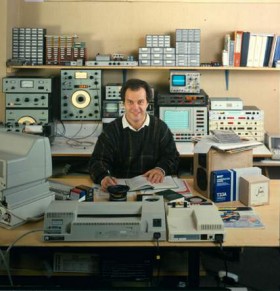Tratto da HFD – Retailing Home Furnishings. February 7, 1983
In basso trovate anche la traduzione italiana
All’ormai famoso (almeno per me) Consumer Electronics Show di gennaio 1983, a Las Vegas
all’hotel Riviera non è passato solo Doug Sax, nella saletta della ESB USA. Ecco un’altra prova di quanto in quell’occasione le “mie” 7/06 DSR possono avere “colpito al cuore” parecchie persone, anche fra le “ben navigate”…
INGLESE (originale)
————————————————-
CROSSTALK
by Ivan Berger
Love at the Circus
WE OF THE PRESS may moan about the extra work at the Consumer Electronics Show and rightly. But secretly, we grin: We’re going to the circus.
Going to the circus is only part of the American dream – it’s also running away with the circus, and falling in love with a beautiful (or handsome) acrobat. I couldn’t run away with this circus; CES goes into mothballs till June. But I did fall in love, there. And thereby hangs a tale.
The object of my new love is a speaker. Not that it matters here which speaker (it’s by ESB; but at $3,000 a pair, it won’t be a mass seller), What does matter is that it illustrates two parallel points, one that I’ve been making for a few years, now, and one that I heard recently from Dr. Amar Bose.
What I’ve been saying is that if high fidelity had a theme song, it should be “What I Did for Love.” What Dr. Bose says is that there is a level of sound quality beyond which music becomes important to the listener even if that was not so before.
What I mean by “love,” is that no one (except audio professionals and musicians) ever bought hi-fi out of real necessity. They buy from love of music, or love of technology, or (as in my case) both. That actually makes the first sale easy, because there is some love of music in nearly everyone. It may not come to much (Lord knows there are radios and phonographs that sound no more like music than a buzz-saw does), but it does come to something: nearly everyone has some kind of sound machine these days.
But the subsequent sales come harder. When the customer already has something, it takes not just a touch of the new-and-improved but a positive jolt of it to make him take out his wallet and buy. It’s not enough to like the product; he must love it. The better the system he already has, the more the next jolt of loveworthy improvement will cost. It’s been years, in fact, since I’ve gotten it out of equipment that I could afford. If I get those speakers, its no sign I can afford them, but just a sign that one can sacrifice for love.
MY CASE ONLY illustrates my own dictum, not Dr. Bose’s. Music already means a lot to me. My illustration for that is a friend who went around the Riviera’s sound suites with me – no audiophile, and not much of a music-lover, either. Walking around the Riviera, though, listening only to good, clean (and expensive) equipment, she found herself rnarvelling that she liked classical music, at least then and there, though she had never liked it much before. The music was something she could get on her FM or phonograph; but the sound was totally different – above Dr. Bose’s threshold, and therefore, suddenly, important to her.
This squares, in a way, with my own test for great vs. merely good sound. When the sound is good, I ask “What system is that?” But when it’s great I ignore the system altogether, and ask for the name and number of the record. The system, in other words, is “good enough’ as soon as we cease being conscious of it, and listen through it, to hear only the music beyond.
That rarely happens, of course. The more familiar we become with how a system sounds, the more its warts and failings become noticeable. No man but a newlywed ever had a perfect wife, content as he may be with the woman he’s married to. The wife of the happily-long-married man is appreciated without having to be perfect, and is all the more comfortable for that.
As we become familiar with our sound systems, we learn to live with their imperfections, too. The differences are there is no moral onus on the listener who trades in a hi-fi system for a better one, and there is an entire industry whose raison d’etre is getting him to do so.
That’s part of our industry’s problem. Most of our market is with people who already have something to listen to, and something that seems at least pretty good to them, or is the best they can bring themselves to afford. The only way to make them move out of that to something better is to make them fall in love. The commitment really isn’t to hardware (except for techno-freaks, who form a small if hard-spending portion of our audience) but to art, to the music coming out of the eqthpment. And appreciating art is a matter of applying knowledge and Intelligence to love.
Ivan Berger is technical editor of Audio
VERSIONE ITALIANA
————————————————-
CROSSTALK
di Ivan Berger
Amore al Circo
NOI DELLA STAMPA possiamo lamentarci del lavoro extra al Consumer Electronics Show e giustamente. Ma segretamente, noi scherzando diciamo: stiamo andando al circo.
Andare al circo è solo una parte del sogno americano – è anche scappare con il circo, e innamorarsi di una bella (o bello) acrobata. Non potevo scappare con questo circo; il CES va in naftalina fino a giugno. Ma mi sono innamorato, lì. Ed ecco come.
L’oggetto del mio nuovo amore è un diffusore. Non che sia importante qui quale diffusore sia (è della ESB, ma a $ 3.000 la coppia, non sarà un prodotto di massa), ciò che conta è che illustra due concetti paralleli, uno in cui credo da diversi anni, l’altro che ho sentito esprimere di recente dal Dr. Amar Bose.
Quello che dico da molto tempo è che, se l’alta fedeltà avesse una canzone a tema, questa dovrebbe essere “What I Did for Love. (n.d.t. Cosa o fatto per Amore.)”.
Mentre quello che dice il dottor Bose è che c’è un livello di qualità del suono oltre il quale la musica diventa importante per chi ascolta. Anche se prima non lo era.
Quello che intendo con “amore”, è che nessuno (tranne i professionisti audio e i musicisti) ha mai comprato hi-fi per reale necessità. Si compra grazie all’amore per la musica, o per la tecnologia, o (come nel mio caso) entrambi. Ciò rende effettivamente la prima vendita facile, perché c’è un po’ di amore per la musica in quasi tutti noi.
Questo non può condurre molto lontano (il Signore sa che ci sono delle radio e dei fonografi il cui suono non è più simile alla musica di quello di una sega), ma una conseguenza ce l’ha: quasi tutti posseggono un qualche tipo di macchina del suono, di questi tempi.
Ma sono le vendite successive ad essere più difficili. Quando il cliente ha già qualcosa, ci vuole non solo un tocco di nuovo e migliore, ma una scossa positiva per fargli estrarre il portafoglio e comprare. Non basta che il prodotto ci piaccia; lo si deve amare. Migliore è il sistema che si ha già, più il prossimo miglioramento costerà.
Sono passati anni, in effetti, da quando ho smesso di desiderare attrezzature che potevo permettermi. Se dovessi acquistare questi diffusori non significherebbe che me li posso permettere, ma solo che per amore si possono fare dei sacrifici.
Il mio caso illustra solo il mio motto, non quello del dottor Bose. La Musica significa già molto per me. La controprova è una mia amica che ha girato le suite del Riviera Hotel con me – non è una audiofila, e nemmeno melomane.
A spasso per il Riviera, però, ascoltando apparecchi capaci di un suono buono, pulito (e costoso), si meravigliò che le piaceva la musica classica, almeno lì per lì, anche se a lei non era mai piaciuto molto prima.
La musica era qualcosa che lei avrebbe potuto ottenere dal suo ricevitore FM o dal fonografo, ma il suono era totalmente diverso – sopra la soglia indicata dal dottor Bose, e, quindi, improvvisamente importante per lei.
Questo quadra, in un certo senso, con il mio test personale per distinguere un grande suono da uno semplicemente buono.
Quando il suono è buono mi chiedo: “Che sistema è?”. Ma quando è grande ignoro il sistema del tutto, e chiedo il nome e il numero del disco. Il sistema, in altre parole, è “abbastanza buono” appena cessiamo di esserne consapevoli, e ascoltiamo attraverso di esso solo la musica al di là.
Questo accade raramente, naturalmente. Più familiari si diventa con il modo in cui un sistema suona, tanto più i suoi difetti e le mancanze diventano evidenti. Nessun uomo, se non uno sposino fresco, ha mai avuto una moglie perfetta né può essere più felice di lui per la donna che ha sposato. La moglie dell’uomo felicemente sposato da lungo tempo è apprezzata senza dover essere perfetta. Ed è tanto meglio per questo.
In modo simile si diventa familiari con i sistemi audio. Impariamo a vivere anche con le loro imperfezioni. La differenza è che non vi è alcun onere morale a carico dell’ascoltatore che cambia un sistema hi-fi per uno migliore, e c’è un intero settore la cui ragion d’essere consiste nel convincerlo a farlo.
Questo è parte del problema della nostra industria. La maggior parte del nostro mercato è con persone che già hanno qualcosa da ascoltare, ed è qualcosa che a loro sembra già abbastanza buono, o è il meglio che possono permettersi. L’unico modo per farli andare oltre verso qualcosa di meglio è farli innamorare.
L’impegno degli operatori non deve essere realmente nell’hardware (ad eccezione che per i puri amanti della tecnica, che formano una piccola porzione, anche se capace di spendere molto del nostro pubblico), ma per l’arte, la musica che esce dai loro apparecchi. E apprezzare l’arte è un modo per applicare conoscenza e intelligenza a favore dell’amore.
Ivan Berger è direttore tecnico della rivista Audio
.



